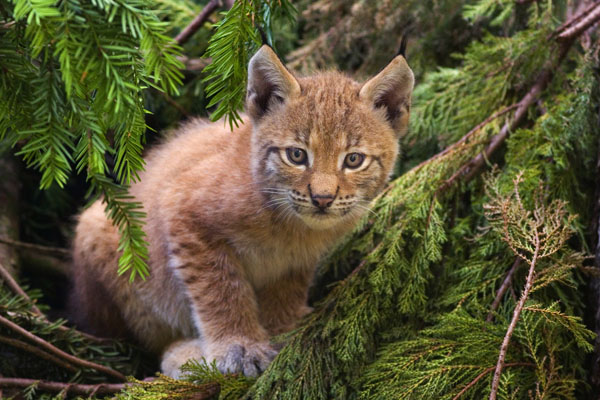EURASIAN LYNX
Lynx (or Felis) lynx
Physical Description
The Eurasian, or Siberian, Lynx is the largest of the lynxes. The Eurasian Lynx has a stout body and long legs. The Lynx’s soft, thick fur is coloured yellow to greyish brown and is marked with faint lines or spots. During the winter, the Eurasian Lynx’s fur lightens in colour and becomes even thicker. The Lynx has long, prominent black ear tufts, and a short, black-tipped tail.
The Eurasian Lynx often has long hair around its neck and under its chin. The Lynx’s large, fur-covered feet function like snowshoes for the animal during the winter. The Lynx’s body measures from 80 to 100 centimetres (2.6 to 3.3 feet) long, the Lynx’s tail measures from 15 to 25 centimetres (5.9 to 9.8 inches) long, and the Lynx stands 15 to 75 centimetres (5.9 to 29.5 inches) at the shoulder. Males weigh an average of 21.6 kilograms (47.6 pounds), while females weigh an average of 18.1 kilograms (39.9 pounds).
Habitat
The Eurasian Lynx primarily inhabits cold coniferous forests. However, the Lynx also lives in deserts and high mountains. The Eurasian Lynx is found throughout Central Asia and across the entire Tibetan Plateau.
Eating Habits
The Lynx predominately eats small ungulates, including roe deer, musk deer, and chamois. When these are scarce, the Lynx supplements its diet with small hares, woodchucks, and foxes. The Lynx kills its prey with suffocation, or by severing the prey’s spinal cord with a bite to the neck.
The Lynx buries what it cannot finish in one meal, returning the next day to finish these leftovers off.
Behaviour and Reproduction
The Lynx is crepuscular, or active at dawn and dusk. The Lynx rests around mid-day and midnight. The Lynx generally remains active in the winter; in extreme weather, though, the Lynx takes shelter in caves or trees. The Lynx is a solitary animal, except for mothers with cubs. However, male lynx territories may overlap the territories of several females. The Lynx marks its territory by urinating on trees and rocks. Female lynx usually mate with only one male per breeding season, but males may mate with more than one female. After a gestation period of 67 to 74 days, Lynx mothers give birth to an average of two kittens, each weighing 200 to 300 grams (seven to 11 ounces). The Lynx is shy and avoids humans when possible. In the wild, the Lynx may live for up to 17 years. The Lynx may live for as long as 24 years in captivity.
Present Status
The Eurasian Lynx is categorized as Near Threatened in the 2003 IUCN Red List of Threatened Species and is listed under Appendix II of CITES.
Hunting of the Lynx is prohibited across most of its habitat range. The Lynx is under second class protection in China and is included in Schedule I, Part I of the Indian Wild Life (Protection) Act of 1972. The population size of the Eurasian Lynx is declining. It is currently estimated at no more than 50,000 mature breeding individuals.
Threats to Survival
The Lynx is hunted for its pelt and is additionally threatened by habitat loss due to deforestation.
References
BBC, Science & Nature – Wildfacts – Eurasian lynx, http://www.bbc.co.uk/nature/wildfacts/factfiles/27.shtml, Aug 2004.
Cat Specialist Group, 2001: Lynx lynx. In: IUCN, 2003: 2003 IUCN Red List of Threatened Species, http://www.redlist.org. See also: http://
lynx.uio.no/catfolk/sp-accts.htm, Aug 2004.
By: Environment and Development Desk, DIIR, CTA.



comment 0